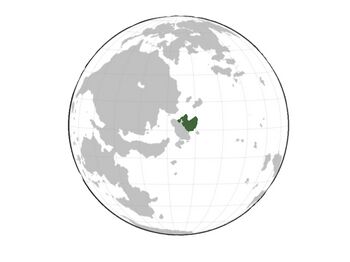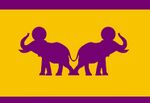Mulak Empire
Empire of Two Abodes (Mulak Empire) Thaichhāti (Rha)
| |
|---|---|
| 331 AD–$$$ | |
|
Flag | |
 Mulak Empire at greatest extent | |
| Capital | Cúbūmā ($$$) |
| Official languages | Standard Rha, Kham Rha |
| Common languages | Rawang, Nhai, Khnem Rha, Sokhaos, Linh, Sichaeng and scores of smaller languages. |
| Religion | Bikåmmā |
| Government | absolute monarchy |
| Mâhåt Rhā | |
• 331-$$$ | Pheihavànphê Sâthōu |
• $$$ | Thú Khōnkhumthat |
• $$$ | TBD |
• $$$-558 | Khedôki Vaisālib |
| Historical era | Pre-Colonial era |
• Pheihavànphê Sâthōu created the Thaichhati | 331 AD |
• TBD | $$$ |
• TBD | $$$ |
• TBD | $$$ |
| Area | |
| $$$$$$ | [convert: invalid number] |
The Mulak Empire, also known as the Mulakan Empire or the Mulāk Empire, and at the time known as the Empire of Two Abodes. The administrative, political and military center of the empire was in the city of Cúbūmā, written also as Khubwihmah. The Mulak civilization arose from the Rhavanese Khamdong Plateau sometime in 331 AD. The Mulak Empire collapsed in 558 AD.
From 331-558, the Mulakans incorporated a large portion of Indonadisi, centered on the Khamdong Plateau. At its largest, the kingdom contained parts of Rhava, Kharai, and Ngoc Luat. Its official language was Rha, while it also used an early form of Kham Rha.[1] Notable features of the Mulak Empire included its monumental architecture, unique to the ethnic Kham Rha people, to succeed in the central-rhavanese enviroment, Rhavanese Beang Khāmkhe bracelets, associated with Sichaeng Baci, and the elaborate caste system.
Etymology
The Mulak called their empire Thaichhāti (taːjcaːti), which means two chhati in standard Rha, two being Thai and Chhāti meaning province or abode.
However it probably would of been spelt Thlaichhāti (t͡ɬaːjcaːti) because of the location of the empire in the Khamdong Plateau, and the Kham Rha dialect's word for two; Thlai.
In Khnem Rha it would be spelt Thnaichhāti (tnaːjcaːti) because two in Khnem Rha is Thnai.
The name Thlaichhāti would've been used to symbolize a united church and state showing heaven and Earth, or maybe the two different terrains in the empire with the lowlands and highlands.
Mulāk (mulaːk/mulaːp) means king in Rha, so another name for Thaichhāti would be the King's Empire.
History
- 7000 BC Rhavanese separate from Sam Ngo settlements and move into the Khamdong
- Rha peoples intermix with Sichaeng and Linh peoples
- 6700s Nomadic clans start popping up
- 6000s nomads are administered into Sukhmeng
- 1000s nomads revolt forming the Nam Kham kingdom
- 220s Kham Rha leader, Kha Pheit would takeover Thuhksuen kingdom and form Nhan dynasty
- 331 the Kham Rha empire of Thaichhati would form
Religion
The Mulak Empire's religion was the Rhavanese religion of Bikåmmā, and the majority of the people were Bikåmmic. The leader of the empire, the Mâhåt Rhā, proclaimed themselves of incarnates of Rhavanese gods, the majority claiming lineage to Yåmbinnȏk.
After the immense support of Shani Datu's beliefs during Luhk Phôti's reign over the Thūhksuen Empire, Bikåmmā became the main religion of Rhava.
Society
- ↑ "Language of Thaichhati". 17 October 2002.
